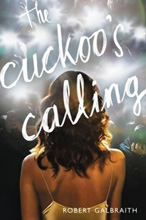 You’ve heard the news. An excellent mystery novel released in April 2013—The Cuckoo’s Calling by Robert Galbraith—was just revealed to have been pseudonymously written by none other than J. K. Rowling of Harry Potter fame. When the news was announced, the blogosphere went insane, the book launched from obscurity to number one bestseller, and people around the world bombarded their local bookstores to try to get their hands on a copy. Fortunately, I heard the news not long after it was announced, and so I managed to find a first-edition copy rather easily so that I could add it to my collection. But as quickly as the next day, the book was scarce everywhere.
You’ve heard the news. An excellent mystery novel released in April 2013—The Cuckoo’s Calling by Robert Galbraith—was just revealed to have been pseudonymously written by none other than J. K. Rowling of Harry Potter fame. When the news was announced, the blogosphere went insane, the book launched from obscurity to number one bestseller, and people around the world bombarded their local bookstores to try to get their hands on a copy. Fortunately, I heard the news not long after it was announced, and so I managed to find a first-edition copy rather easily so that I could add it to my collection. But as quickly as the next day, the book was scarce everywhere.
I bring this up because it emphasizes the dichotomy that still exists within the realm of books. Personally, and obviously, I’m still very much in the physical-book mindset. My first reaction to the Rowling news, as I said, was to rush out and find a first-edition hardcover. It’s ingrained in my psyche. I view books as much more than their text; to me, they’re works of art that comprise not only the text but the cover art, the design, the feel of the pages, the heft, the look. But, as I’ve mentioned before (in “The End of Everything”), that’s a dying perspective. The majority of people hearing this news probably simply added the e-book to their Kindle archive.
Every once in a while, we see a phenomenon like this breathe new life into the would-be corpse that is the physical book. Last year, Fifty Shades of Grey boosted the profits of brick-and-mortar bookstores worldwide, letting those stores survive at least a little while longer. They were only scraping by with sales of all their other titles, but that one trilogy seemed to ward off the inevitable. There are other efforts to stave off a slow death, such as Stephen King’s recent decision to release his Hard Case Crime mystery Joyland only in a physical incarnation.
(Read the rest at Residential AV Presents: Connected Home.)





